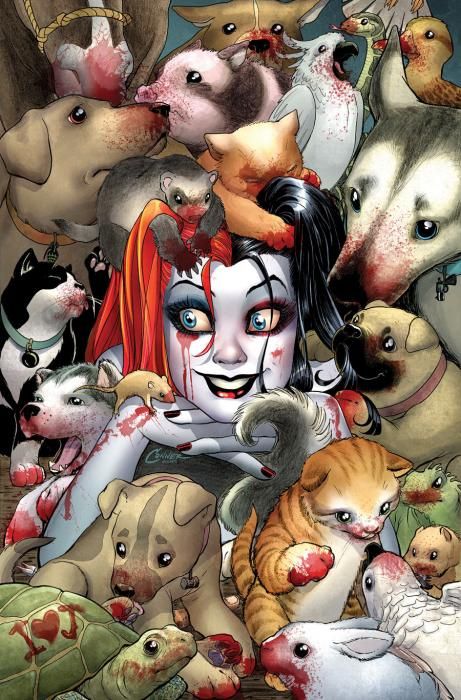"Harley Quinn" #2 feels to be a template for what's to come in the series, after the fourth-wall-breaking #0 and the all-new-set-up #1. While Stephane Roux pitches in on the art, on the whole I think it's fair to say that Amanda Conner, Jimmy Palmiotti and Chad Hardin have a good handle on "Harley Quinn" and how the book should move forward.
Conner and Palmiotti's take on Harley Quinn is a mixture of whimsy and violence, and I feel like that works for the character. As the Joker's sometimes-accomplice (and girlfriend), the idea of her hands being clean of the death and destruction that he's achieved over the years is a little hard to swallow. The creative team presents someone who's not afraid to kill people who are coming after her, but at the same time she's not a homicidal maniac slaughtering everyone in her path. Bodies are piling up, but for a reason; that's a good balance. It also helps that Conner and Palmiotti take the most gruesome moment in "Harley Quinn" #2 and let it happen off-panel. There's certainly a very strong insinuation on what happens next, but at the same time there's certainly some wiggle room if you'd like to think that someone was only roughed up rather than devoured.
Having Poison Ivy show up this issue was a smart step. First, it allowed the more humorous and fun side of Harley to show up here. The Harley-and-Ivy team-ups are almost always fun, and I can't help but think that they inspire any writers who tackle them. Conner and Palmiotti bring to life the playful side of Harley whenever she's around Poison Ivy in "Harley Quinn" #2, and I appreciate that they let Ivy in on a story where it's not involving saving plants for a change. Add in the fact that Harley's talking with Madame Macabre, the owner of the House of Wax and Murder museum that's on the ground floor of her new home, and there's certainly a vein of humor running throughout the book.
Hardin and guest artist Roux's styles mesh so well in "Harley Quinn" #2 that I'll bet some readers won't even notice the shift. Roux's is a little more realistic than Hardin's, but I'll leave it to the audience to decide which of the two they enjoy more. Both of them have a beautiful soft line, with incredibly expressive characters. Harley's eyes welling up with tears when she finds out about the kill-shelter is hysterical, even as the nasty look on her face when she announces that she has to set an example while throttling the latest assassin is rather chilling. Hardin and Roux both do a good job of playing off the idea of the different sides of Harley that Conner and Palmiotti's script runs with.
In the end, "Harley Quinn" #2 is a comic where the villain both talks to a dead stuffed (partially burnt) beaver and saves shelter animals, even as she also brutally kills those who are trying to kill her first. She's a character that contains multitudes, and I feel like this book is doing a good job of juggling the different sides of the character. So far, so good.

